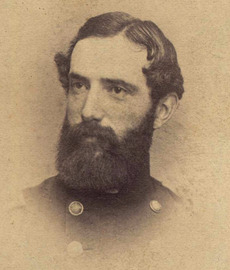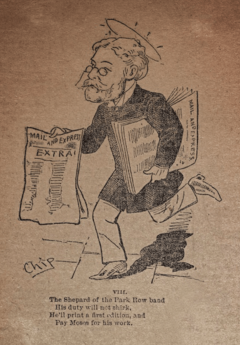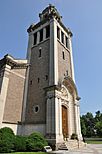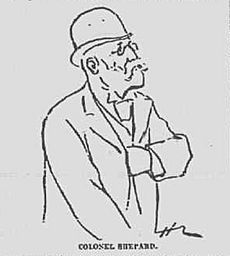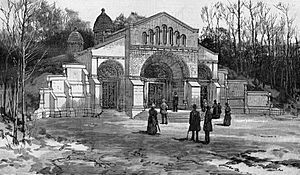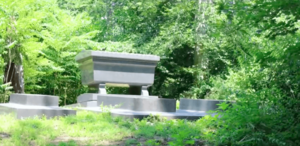Elliott Fitch Shepard facts for kids
Quick facts for kids
Elliott Fitch Shepard
|
|
|---|---|
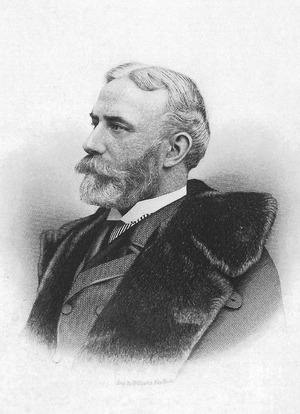
Portrait of Elliott Fitch Shepard from 1890
|
|
| Born | July 25, 1833 |
| Died | March 24, 1893 (aged 59) |
| Resting place | Moravian Cemetery |
| Alma mater | City University of New York |
| Political party | Republican |
| Spouse(s) |
Margaret Louisa Vanderbilt
(m. 1868; w. 1893) |
| Children | 6, including Alice, and Elliott Jr. |
| Signature | |
 |
|
Elliott Fitch Shepard (born July 25, 1833 – died March 24, 1893) was an important person in New York. He was a lawyer, a banker, and owned a newspaper called the Mail and Express. He also helped start the New York State Bar Association and was its president.
Shepard married Margaret Louisa Vanderbilt. She was the granddaughter of Cornelius Vanderbilt, a very rich and famous businessman. Shepard's home, called Woodlea, and the Scarborough Presbyterian Church he founded, are both in Briarcliff Manor, New York. These places are now part of a special historic area.
Shepard was born in Jamestown, New York. His father was in charge of a company that printed banknotes. Elliott went to the City University of New York and worked as a lawyer for about 25 years. During the American Civil War, he helped recruit soldiers for the Union Army and became a colonel. He later helped start several important organizations and banks.
Contents
Early Life and Education
Elliott Shepard was born on July 25, 1833, in Jamestown, New York. He was one of three sons of Fitch Shepard and Delia Maria Dennis. His father was the president of a company that printed money. Elliott's brother, Augustus, later became president of another big banknote company.
Elliott's family had a long history in New England, with roots in England. His father's family were descendants of early American settlers. Elliott was described as important not just because of his family, but also for his own good qualities.
He went to public schools in Jamestown. In 1845, when he was 12, he moved with his family to New York City. He then went to the University Grammar School, which prepared students for college. He graduated from the City University of New York in 1855. After college, he studied law with a lawyer named Edwards Pierrepont. He officially became a lawyer in Brooklyn in 1858.
Military Service in the Civil War
From 1861 to 1862, during the start of the American Civil War, Elliott Shepard worked as an assistant to Union Army General Edwin D. Morgan. He held the rank of colonel. During this time, he was in charge of volunteers in Elmira, New York. He helped sign up 47,000 men from that area to join the army.
In 1862, he was made Assistant Inspector-General for half of New York state. His job was to report to the governor about how the troops were organized, what equipment they had, and how well they were trained.
Shepard also helped recruit and organize the 51st Regiment, New York Volunteers. This group was even named the "Shepard Rifles" in his honor. He was offered a promotion to brigadier general by President Abraham Lincoln. However, Shepard politely turned it down. He felt that officers who had actually fought in battles deserved the promotion more, as he had not seen field combat.
A Busy Career
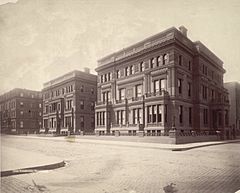
Elliott Shepard was very involved in helping others. In 1864, he was part of a committee for a big fair in New York that raised money for soldiers. He also led groups of lawyers who helped with disaster relief. This included after the big fires in Portland, Maine (1866) and Chicago (1871). He also helped victims of the Johnstown Flood in 1889.
In 1867, he met Margaret Louisa Vanderbilt. Her father, William Henry Vanderbilt, was not happy about their relationship at first. But they got married on February 18, 1868, in New York City.
After a trip to Turkey in 1868, Shepard helped start Tarsus American College. He promised to donate money to the school every year and leave a large sum of money for it when he died. He became a trustee and vice president of the school.
Shepard continued to practice law for 25 years. He helped create the New York State Bar Association in 1876 and later became its president. In 1880, he was asked to help update and organize all of New York City's local laws.
During the 1880s, he helped start three banks: the Bank of the Metropolis, the American Savings Bank, and the Columbian National Bank. In 1888, Shepard bought the Mail and Express newspaper. He was a very religious man, so he put a Bible verse at the top of the editorial page in every edition. He was president of the newspaper company until he died.
When Margaret's father died in 1885, she inherited a lot of money. The family lived in a large house in Manhattan that was part of the Vanderbilt Triple Palace.
Shepard and his family traveled the world in 1884, visiting Asia, Africa, and Europe. He wrote about a trip he took to Alaska in 1887 with his family and many staff members. He said they traveled over 14,000 miles and stayed in many hotels. After his 1884 trip, he started a church mission in Alaska and supported it with his wife. He was also very active in the Presbyterian church and worked to encourage people to keep Sunday as a day of rest.
Developing Briarcliff Manor
In the early 1890s, Shepard moved to Scarborough-on-Hudson, which is now part of Briarcliff Manor. He bought a house and then built a huge mansion nearby called Woodlea. It faced the Hudson River. Construction of Woodlea started in 1892, but Shepard died in 1893 before it was finished. His wife, Margaret, made sure it was completed. The finished house was very large, one of the biggest private homes in the United States.
After Shepard's death, Margaret lived at Woodlea for part of the year. Later, she sold the house and land to Frank A. Vanderlip and William Rockefeller. They turned Woodlea into the clubhouse for the Sleepy Hollow Country Club.
Shepard also started a small chapel on his property and founded the Scarborough Presbyterian Church in 1892. After he died, Margaret donated the church and its nearby house to the community. The church was designed by his nephew and dedicated in his memory in 1895.
Family and Personal Life
Elliott and Margaret Shepard had six children: five daughters and one son. Their children went to Sunday school and church. They were taught at home by private teachers.
Shepard was described as a tall man with a pleasant look. The New York Times called him a "perfect type of well-bred clubman." He had thick hair, a well-trimmed beard, and was athletic. He was against antisemitism (prejudice against Jewish people). He often attended events to help Russian Jews and spoke to Jewish groups. He was known for being very generous to hospitals and charities.
Shepard was interested in politics and wanted to be powerful. He built Woodlea to show his importance. He loved horses and riding. He was a strong supporter of the Republican Party and gave a lot of money to their campaigns. He even provided a building for the Republican Club in New York City for free.
Shepard belonged to many different clubs and organizations. These included the American Museum of Natural History, the Metropolitan Museum of Art, and the New York Yacht Club. In 1892, he received advanced law degrees from the City University of New York and the University of Omaha.
Later Life and Legacy
Elliott Shepard died suddenly on March 24, 1893, at his home in Manhattan. He passed away during a medical procedure.
His funeral was held at the Fifth Avenue Presbyterian Church. Many people attended, including family members, friends, and representatives from all the organizations he was part of.
Shepard was first buried in the Vanderbilt family mausoleum. Later, his remains and those of his infant daughter, Florence, were moved to a new Shepard family tomb nearby in the same cemetery.
Shepard's estate (all his money and property) was worth a lot. His will gave money and property to his wife, children, brother, and several religious organizations. He also funded scholarships and prizes at the City University of New York and New York University. He donated a large collection of law books to the New York University School of Law and helped create the university's first reading room.



